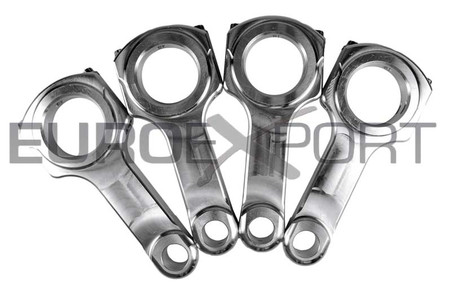- Home
- Bottom End
- Suzuki 1.3L G13 Aluminum Billet Connecting Rods w/ ARP2000 Rod Bolts
Product Description
Aluminum connecting rods. Include ARP2000 rod bolts. Fit Suzuki Cultus, Swift, Samurai with 1.3L G13 engines. Made in the United States. Free expedited shipping to the United States and Puerto Rico.
Molnar connecting rods are CNC machined out of their proprietary aluminum alloys. The alloy has up to 24% increased tensile and yield strength over competitors rod alloys. All alloys are cold extruded under 2,000+ tons of pressure to ensure consistent grain flow and density. This yields the strongest and lightest rod possible with an exceptional fatigue life and reduced elongation. As with all our connecting rods, the material has been ultrasonically tested, bores are precision honed to standards, mating surfaces are standard or circle-loc serrated for super-strength and perfect cap to rod alignment, and all corners are blended to eliminate stress risers. All connecting rods come standard with ARP2000 rod bolts.
Fully Machined Billet, Not Forged
Balanced +/- 1.0 Gram
ARP Fastener
Applications:
Suzuki 1.3L G13 engine
- 1986–1989 Suzuki Samurai
- 1986-1989–Suzuki Swift GTi AA33S
- 1989-1994– Suzuki Cultus GTi AA34S (113HP)
- 1990– Suzuki Cultus AB34S
- 1989– Suzuki Swift AC34S DOHC
- 1989–1997 Suzuki Swift
What is the difference between a forged and aluminum connecting rod?
Forgings are easier and cheaper to manufacture and until CNC machining became popular, this was the only economical way to manufacture an aluminum connecting rod. Billets actually cost more, but the finished product is actually stronger and lasts longer. Part of this is due to how the billets are manufactured, as extrusions allow for directionality of the grain structure, adding to how well Aluminum Connecting Rods function as a shock absorber. Same goes with a forged versus billet crankshaft – billet is always better!
What clearances do I need to run with an aluminum connecting rod?
When running an aluminum connecting rod, your running clearances need to be adjusted as the aluminum connecting rod will grow more than a steel rod. A piston to head clearance of .060″ minimum is recommended. Sides clearances need to be increased by .002-.005″ over the steel counterpart depending on application and oil viscosity used. Wrist pins typically need to be run tighter than their steel counterpart as the heat from the piston transfers to the rod and increases running clearances during operation. Rod bearing clearances typically are run .001-.002″ looser than with steel rods as the parting lines tend to burnish into each other during initial operation. Aluminum connecting rod to camshaft and engine block clearances should also be kept to a minimum of .060″.
 Loading... Please wait...
Loading... Please wait...





